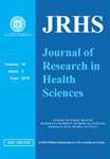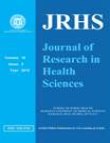فهرست مطالب

Journal of Research in Health Sciences
Volume:17 Issue: 3, Summer 2017
- تاریخ انتشار: 1396/06/01
- تعداد عناوین: 7
-
-
Page 1BackgroundReproduction rates are declining in Hamadan, western Iran. This study identified the influence factors associated with reproduction rate and birth spacing in Hamadan as an area of low population growth in Iran.
Study design: A cross sectional study.MethodsThe study considered reproductive status of 812 women referred to health care centers of Hamadan, western Iran in 2015. Data were obtained through frequency and percentage. PWP-GT model was used to determine the influence factors on women's reproductive by R software (version 3.3.2). The parity progression ratios were determined based on Yadava and Kumar.ResultsThe median time for the second, the third and the fourth birth was 4.53, 4.65 and 5.27 yr, respectively. PWP-GT model showed that women age at marriage (P=0.001), women's (P=0.005) and their husband's (P=0.039) employment had significant effect on time birth of first child. The women's education (P=0.001) was the only variable that had a significant effect on the birth time from the first to the second child as well as from the third to the fourth child. Education of women (P=0.001) and their husbands (P=0.034) had significant effect on the time interval from the second to the third child. The birth probability from marriage to the first birth (0 to 1st child) was high (0.91), while the probability had been fallen from the third birth and more (0.31).ConclusionsBirth spacing in Hamadan is more than WHO recommended. In addition, reducing of the population growth and childbearing has started in the past few decades in Hamadan the same as Iran. The chance of fertility has dramatically declined from the third child and then.Keywords: Survival analysis, Reproductive, Birth interval -
Page 2BackgroundCholesterol level (CL) is growing concerned as health issue in human health since it is considered one of the causes in heart diseases. A study of cholesterol level can provide insight about its nature and characteristics.
Study design: A cross-sectional studyMethodsNational Health and Nutrition Examination Survey (NHANS) II was conducted on a probability sample of approximately 28,000 persons in the USA and cholesterol level is obtained from laboratory results. Samples were selected so that certain population groups thought to be at high risk of malnutrition. Study included 11,864 persons for CL cases with 9,602 males and 2,262 females with races: whites, blacks, and others. Non-parametric statistical tests and goodness of fit test have been used to identify probability distributions.ResultsThe study concludes that the cholesterol level exhibits significant racial and gender differences in terms of probability distributions.
The study has concluded that white people are relatively higher at risk than black people to have risk line and high risk cholesterol. The study clearly indicates that black males normally have higher cholesterol. Females have lower variation in cholesterol than males.ConclusionsThere exists gender and racial discrepancies in cholesterol which has been identified as lognormal and gamma probability distributions. White individuals seem to be at a higher risk of having high risk cholesterol level than blacks. Females tend to have higher variation in cholesterol level than males.Keywords: Cholesterol, malnutrition, heart disease -
Page 3BackgroundDrug abuse, particularly intravenous drug use, is one of the most common challenges in human communities so that its negative impact on economic and cultural conditions of society and physical as well as mental health of individuals is evident. We aimed to estimate the IDUs population in Kermanshah City, West of Iran using Capture-recapture method.
Study Design: A Cross-sectional study.MethodsThe data in this study were collected from three different sources: Drop in Centers (DICs), Out Reach Teams (ORTs) and Methadone Maintenance Treatment centers (MMTs) in Kermanshah City from Mar 2015 until Mar 2016, and then indirect Capture-recapture was used to estimate the IDUs population.ResultsThe number of IDUs registered in DICs, ORTs, and MMTs were 694, 731, and 156 cases, respectively. Having determined the commonalities and removing duplicates, the number of drug users registered were 1,375 cases, after analysis of data, the number of drug users not registered in any center was estimated as 2,042 (95% CI: 1708, 2444). By counting 1,375 cases recorded in these sources, the total number of injection drug users in the Kermanshah City was about 3,417 people, (95% CI: (3083, 3819).ConclusionsThe prevalence of IDUs in Kermanshah City is high, which could cause severe economic and social problems in the society. To reduce the negative effects of drug use, awareness and measuring of the drug users population, seem to be necessary overtime.Keywords: Capture-recapture, Intravenous Drug Users, Iran -
Page 4BackgroundThe use of condoms is important for preventing Sexually Transmitted Infections (STIs). However, the prevalence of condom use is not satisfactory. The aim of this study was to assess the reasons for inconsistent condom use in Iranian adults.
Study design: Cross-sectional study.MethodsData were gathered through multi-stage sampling. Participants were enrolled from 13 provinces in Iran aged between 19 and 29 years. They had ever-extramarital sex and did not use condoms regularly in their sexual contacts, asked the reasons for inconsistent condom use.ResultsWe had 3,246 adults, from which 635 (19.5%) had ever-extramarital sex. Among them, 495 (77.96%) did not use condoms with regularity. The reason frequently chosen for inconsistent condom use was that it is not accessible (49.3%). The differences between the categories of some variables, according to the choice of reasons for inconsistent condom use, were significant (PConclusionsMost of the reasons that were selected for inconsistent condom use were inaccessibility and not knowing that its use is essential. Hence, it is important to improve the knowledge of adults regarding STI/HIV and extend the locations of condom distribution. We should try to promote the culture of condom use as a routine.Keywords: Condom, Adults, Iran, Multilevel analyses, Multivariate -
Page 5BackgroundThailand is one of the members of WHO FCTC and has paid so much attention to preventing adolescents access to tobacco. However, Thai adolescents still have access to tobacco with ease. The aim of this research was to investigate the predicting factors for the cigarettes sale to adolescents by the retailers in Thailand.
Study design: A cross-sectional survey.MethodsThis cross sectional survey was conducted after a careful desk review of the relevant literature. Multistage random sampling technique was used to sample the survey participants (n = 675) who were retailers of tobacco in the lower northern region of Thailand. Data were collected by validated questionnaires and analyzed by descriptive analytic, chi-square test and binary logistic regression.ResultsMore than half (58.7%) of the participants sell cigarettes to adolescents. Factors such as open display of cigarette at the point of sale, selling cigarettes in sticks, selling cigarettes by self-service, and reluctant disregard of buyers age by the seller significantly correlated with and predicted, at 95% level of confidence, the behavior of retailers selling cigarettes to adolescents.ConclusionsThai adolescents access to tobacco continues to be a serious public health problem. Therefore, the Ministry of Public Health and other relevant stakeholders saddled with the responsibility of interventions to scale up measures that would reinforce the law of Tobacco Control Act.Keywords: Cigarettes, Adolescent, Thailand -
Page 7BackgroundDocumentation of achieving the goal of measles elimination to justify to international organizations including the WHO is a priority for public health authorities. This study aimed to address the status of Iran in the achievement of the measles elimination goal from 2012-2014.
Study Design: A descriptive studyMethodsData on the measles outbreaks were extracted from the national notifiable measles surveillance system in Iran from 2012 to 2014. The required documents regarding the achievement of measles elimination, including Effective Reproduction Number (R) and the distribution of outbreak size, was addressed. The R was calculated using the proportion of imported cases as 1 − P, where P is equal to the proportion of cases that were imported. The distribution of the measles outbreaks size was described using descriptive statistics to show their magnitudes. The proportion of large outbreaks with more than 10 cases was considered as a proxy of the R value.ResultsThe total number of measles cases was 232 cases (including 186 outbreak related cases) in 2012 and 142 cases in 2014, including108 outbreak related cases. The distribution of the measles outbreak size of occurred outbreaks from that period indicated that there were 37 outbreaks with three or more than three cases. The R value in 2012 was 0.87 and the corresponding value for 2014 was 0.76.ConclusionsAccording to the magnitude of effective reproduction number and distribution of outbreak's size, measles has been eliminated in Iran. However, it is necessary to consider the potential endemic activity of measles because of no authorized immigration.Keywords: Infectious Diseases, Measles, Elimination, Reproductive number, Iran


